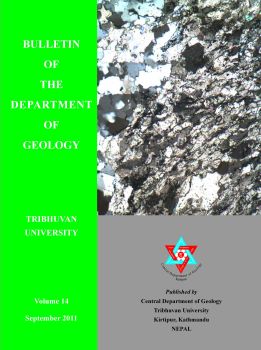River dynamics and existing stability condition of the Manahara River, Kathmandu basin, Central Nepal Himalaya
DOI:
https://doi.org/10.3126/bdg.v14i0.5430Keywords:
geology, morphology, planform geometry,Abstract
Five representative segments of the river were surveyed in detail for evaluating its dynamics and stability condition. The first(downstream) to the fifth (upstream) segments are classified as ‘F4’, ‘C4’, ‘C4’, ‘B4’ and ‘B4’ streams characterised by gravellysubstrates. All these streams are competent enough to transport their bed material (d90) as shown by the exceeding dimensionlessshear stress over critical dimensionless shear stress of the river segments. The existing depth and slope of the river is far enoughto carry d90 of the substrate grain size. Stream power of segments 1 to 5 are respectively, 622.6, 79.0, 146.6, 354.6 and 15617.0KN/s. The ‘B4’ streams show greater stream power, i.e., transport capacity compared to ‘F4’ followed by ‘C4’ streams. Therefore,the ‘B4 streams (3rd and 4th order streams) are potential to degradation, and the ‘C4’ and ‘F4’ (both 5th order) streams arepotential to aggradation depending on river morphology and dynamics. Meander geometry of the Manahara River exhibit deviationof variables (meander wavelength vs channel width, and meander belt width vs channel width) from the stability, suggestingexistence of instability to some extent in the river.
DOI: http://dx.doi.org/10.3126/bdg.v14i0.5430
Bulletin of the Department of Geology Vol.14 2011, pp.1-8
Downloads
Downloads
How to Cite
Issue
Section
License
© Central Department of Geology, Tribhuvan University, Nepal

